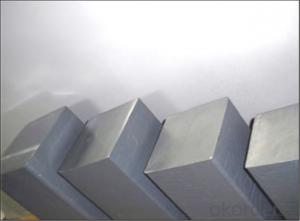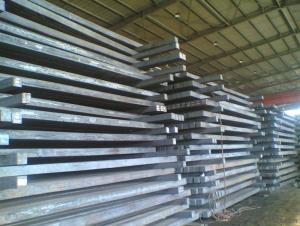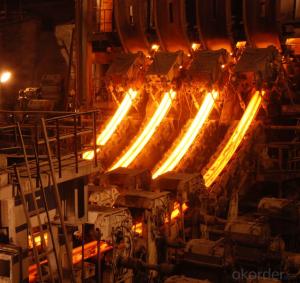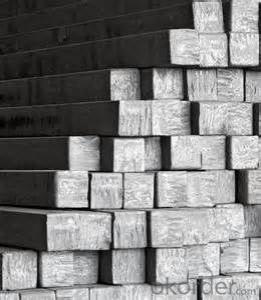Square Steel Billet Q235 3SP Grade Prime Quality 11#
- Loading Port:
- Tianjin
- Payment Terms:
- TT OR LC
- Min Order Qty:
- 2000 m.t
- Supply Capability:
- 50000 m.t/month
OKorder Service Pledge
OKorder Financial Service
You Might Also Like
Description of Square Steel Billet Q235 3SP Grade Prime Quality 11#
M. S. Billets are used for rolling of TMT Re-Bars of Fe415 and Fe500 Grade and various other structural steel products.
CRS Billets are used for rolling of CRS TMT Re-Bars.
Special Alloy Billets are used for rolling of any special grade TMT Re-Bars like Earthquake resistant TMT Re-Bars and for special grade structural steel products.
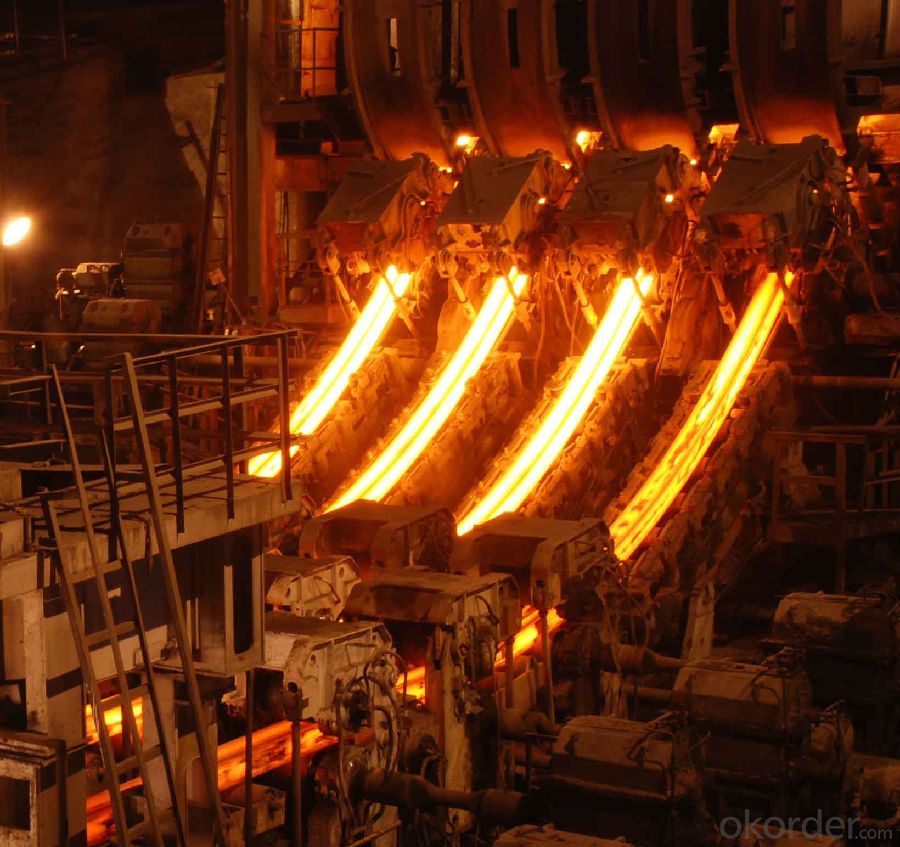
Main Feature Square Steel Billet Q235 3SP Grade Prime Quality 11#
Raw elements(C,Fe,Ni,Mn,Cr,Cu.)---Smelted ingots by AOD finery---hot rolled into black suface---pickling in acid liquid---cold drawn----polished by automatically machine--- cutting into pieces---checking quanlity
Applications of Square Steel Billet Q235 3SP Grade Prime Quality 11#
Widely Used in the areas such as Stainless Steel Fasteners, Chains, Kitchen and Sanitary wares, Furniture handles, Handrails, Electroplating and Electrolyzing pendants, Foods, Electron, Petroleum, Construction and Decoration, etc. Products have a high strength after cold-working. Electronic products parts, Medical appliance, Springs, Bus Inside and Outside packaging and building, Street Lamp Posts, etc. Decoration materials and Outdoor Publicity Billboard. Used for the products which have the Anti-Stress Corrosion requirement. Electron Products, Table-wares, Bolts, Nuts, Screen Meshes, Cumbustors and so on.
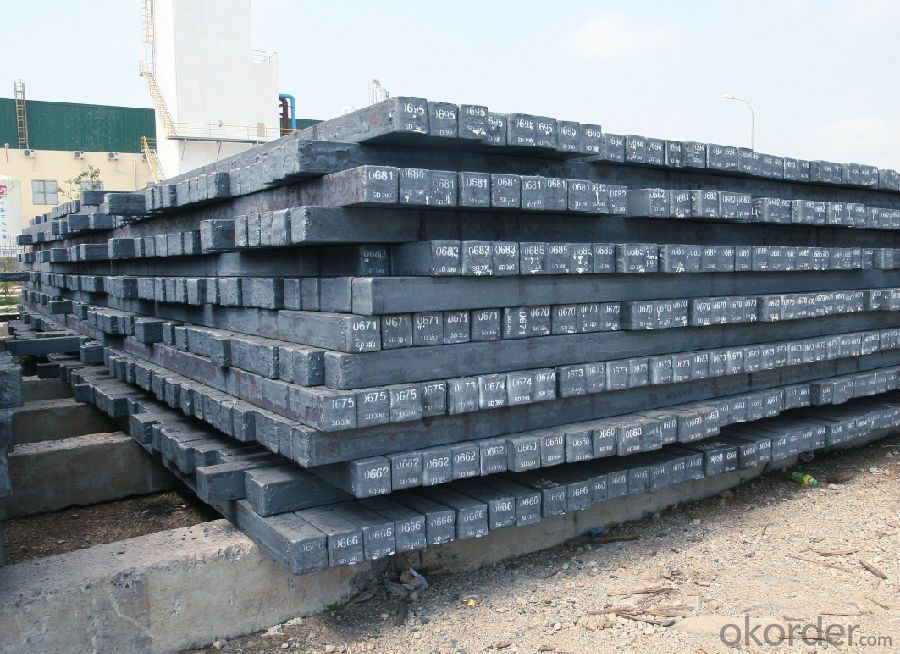
Specifications of Square Steel Billet Q235 3SP Grade Prime Quality 11#
| Standard | C(%) | Mn(%) | S(%) | P(%) | Si(%) |
| Q195 | ≤0.12 | ≤0.50 | ≤0.040 | ≤0.035 | ≤0.30 |
| Q235 | ≤0.20 | ≤1.40 | ≤0.045 | ≤0.045 | ≤0.35 |
| Q275 | ≤0.22 | ≤1.50 | ≤0.045 | ≤0.045 | ≤0.35 |
| 20MnSi | 0.17-0.25 | 1.2-1.6 | ≤ 0.050 | ≤ 0.050 | 0.40-0.80 |
| 3SP | 0.14-0.22 | 0.40-0.85 | ≤ 0.050 | ≤ 0.040 | 0.05-0.15 |
| 5SP | 0.28-0.37 | 0.50-1.00 | ≤ 0.050 | ≤ 0.040 | 0.15-0.30 |
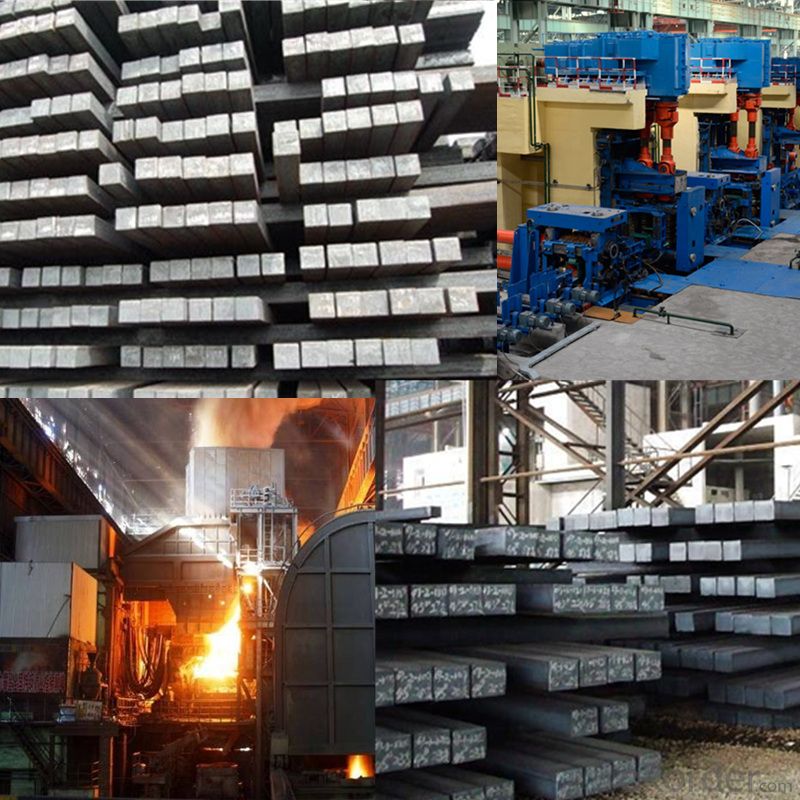
FAQ of Square Steel Billet Q235 3SP Grade Prime Quality 11#
We have organized several common questions for our clients,may help you sincerely:
1. How Can I Visit There?
Our company is located in Tianjin City, China, near Beijing. You can fly to Tianjin Airport Directly. All our clients, from home or aboard, are warmly welcome to visit us!
2. How Can I Get Some Sample?
We are honored to offer you sample.
3. Why choose CNBM?
Our delivery time about 15-20days for standard sizes, if you have other requirements like hardness, quanity and width ,it is about 20-40days. But don't worry we also try our best for the delivery time ,because time longer and our cost is higher.
- Q:What is the maximum temperature that a steel billet can withstand?
- The maximum temperature that a steel billet can withstand largely depends on the specific type and grade of steel being used. However, as a general guideline, most steels begin to lose their structural integrity and mechanical properties at temperatures above 800 degrees Celsius (1472 degrees Fahrenheit). At these elevated temperatures, steel starts to undergo significant thermal expansion, which can lead to distortion, warping, and ultimately failure. In certain specialized applications, high-temperature alloys or superalloys can withstand even higher temperatures. These materials are specifically designed to maintain their strength and durability at extreme temperatures, often exceeding 1000 degrees Celsius (1832 degrees Fahrenheit) or more. Nevertheless, it is important to note that the maximum temperature a steel billet can withstand should always be determined by consulting the specific material's technical data sheet or consulting with experts in the field. Variables such as alloy composition, heat treatment, and intended use can all play a role in determining the maximum temperature limit for a steel billet.
- Q:How are steel billets used in the production of agricultural machinery?
- Steel billets are used in the production of agricultural machinery as a raw material for various components such as gears, shafts, and frames. These billets are melted and molded into the desired shape, providing the necessary strength and durability required for the machinery to effectively perform tasks in the agricultural sector.
- Q:If the casting speed is not steady, what will happen to the billet?
- Secondly, the speed of cutting is unstable, and the cut rate will be reduced.
- Q:The role of carbon content in steels
- Therefore, the carbon content determines the use of steel: low carbon steel (carbon content < 0.25%), commonly used as extrusion and stamping materials; carbon steel (carbon content < 0.6%), commonly used as mechanical parts; high carbon steel (carbon content > 0.7%), commonly used tools, tool and mould etc..
- Q:Are steel billets affected by extreme temperatures?
- Yes, steel billets are affected by extreme temperatures. When exposed to high temperatures, steel billets can expand and deform. This is due to the thermal expansion property of steel, where it expands in size as it is heated. On the other hand, when subjected to extremely low temperatures, steel billets can contract and become more brittle. This is because the cold temperature reduces the ductility of steel, making it more prone to fracture. Therefore, it is crucial to consider the effect of extreme temperatures on steel billets when designing, handling, and storing them to prevent any unwanted deformation or failure.
- Q:What are the different types of mechanical property testing methods for steel billets?
- Some different types of mechanical property testing methods for steel billets include tensile testing, hardness testing, impact testing, and fatigue testing. Tensile testing measures the strength and ductility of the material by applying a pulling force until it breaks. Hardness testing measures the resistance of the material to penetration or indentation. Impact testing evaluates the material's ability to absorb energy under high rates of loading. Fatigue testing assesses the material's resistance to failure under cyclic loading conditions.
- Q:What are the different surface finishes available for stainless steel billets?
- Some of the different surface finishes available for stainless steel billets include mill finish, brushed finish, mirror finish, satin finish, and bead blasted finish.
- Q:How do steel billets contribute to the overall strength of a finished product?
- The strength of the finished product heavily relies on the quality of the steel billets used. Steel billets form an essential part of the manufacturing process for various steel products and have a vital role in determining the final product's strength. To start with, steel billets are produced by continuously casting molten steel into solid blocks or forms. This casting method guarantees that the steel billets possess a consistent and uniform structure, which is crucial for maintaining the overall strength of the end product. The uniformity of the billets enables an even distribution of stress and load-bearing capacity throughout the final product. Furthermore, steel billets are typically made from high-quality steel alloys specifically selected for their superior strength properties. These alloys contain elements like carbon, manganese, and other alloying elements that enhance the overall strength and hardness of the steel. The utilization of high-quality steel billets enables manufacturers to create finished products with excellent tensile and yield strength, making them highly resistant to deformation, bending, and breaking. In addition, steel billets undergo various heat treatment processes such as quenching and tempering, which further enhance their strength. Quenching involves rapid cooling of the billets to increase their hardness, while tempering reduces brittleness and improves toughness. These heat treatment processes result in steel billets with improved mechanical properties, including higher yield strength and enhanced resistance to fatigue and impact. Moreover, the size and shape of steel billets also contribute to the overall strength of the finished product. The dimensions of the billets determine the final dimensions of the product, and larger billet sizes allow for a more significant and stronger end product. Similarly, optimizing the shape of the billets improves the load-bearing capacity and structural integrity of the finished product. To conclude, steel billets are crucial for the overall strength of the finished product. Through their uniform structure, high-quality alloys, heat treatment processes, and optimized size and shape, steel billets provide the necessary foundation for the production of robust and long-lasting steel products. Selecting the appropriate steel billets and ensuring their quality throughout the manufacturing process are essential steps in creating a finished product with exceptional strength and performance.
- Q:What are the common surface defects in steel billets?
- Steel billets may exhibit several common surface defects: 1. Scale: During hot rolling, a thin oxide layer called scale may form on the billet's surface. It can appear rough or flaky due to the steel reacting with oxygen in the air. 2. Cracks: Improper cooling or excessive stresses during manufacturing can cause cracks in the billet. These cracks may be longitudinal or transverse and can significantly compromise its structural integrity. 3. Pitting: Small depressions or cavities known as pitting can develop on the billet's surface. Pitting often arises from localized corrosion or reactions with impurities in the steel. 4. Lamination: Lamination defects occur when non-metallic inclusions form layers or sheets within the steel billet. These inclusions weaken the billet and affect its mechanical properties. 5. Surface porosity: Presence of small voids or bubbles on the billet's surface is referred to as surface porosity. This can result from gas entrapment during solidification or improper casting techniques. 6. Inclusions: Non-metallic substances, such as oxides, sulfides, or other impurities, can be present in the steel billet as inclusions. These inclusions can influence the billet's mechanical properties. Identifying and addressing these surface defects in steel billets is crucial to ensure the quality and performance of the final product. Various inspection techniques, including visual inspection, ultrasonic testing, and magnetic particle testing, can be employed to detect and eliminate these defects and ensure the production of superior steel products.
- Q:How are steel billets used in the production of railway wheels?
- Steel billets are used in the production of railway wheels by being heated and then forged into the desired shape. This process helps to create a strong and durable wheel that is capable of withstanding the heavy loads and constant use in railway systems.
1. Manufacturer Overview |
|
|---|---|
| Location | |
| Year Established | |
| Annual Output Value | |
| Main Markets | |
| Company Certifications | |
2. Manufacturer Certificates |
|
|---|---|
| a) Certification Name | |
| Range | |
| Reference | |
| Validity Period | |
3. Manufacturer Capability |
|
|---|---|
| a)Trade Capacity | |
| Nearest Port | |
| Export Percentage | |
| No.of Employees in Trade Department | |
| Language Spoken: | |
| b)Factory Information | |
| Factory Size: | |
| No. of Production Lines | |
| Contract Manufacturing | |
| Product Price Range | |
Send your message to us
Square Steel Billet Q235 3SP Grade Prime Quality 11#
- Loading Port:
- Tianjin
- Payment Terms:
- TT OR LC
- Min Order Qty:
- 2000 m.t
- Supply Capability:
- 50000 m.t/month
OKorder Service Pledge
OKorder Financial Service
Similar products
New products
Hot products
Related keywords
